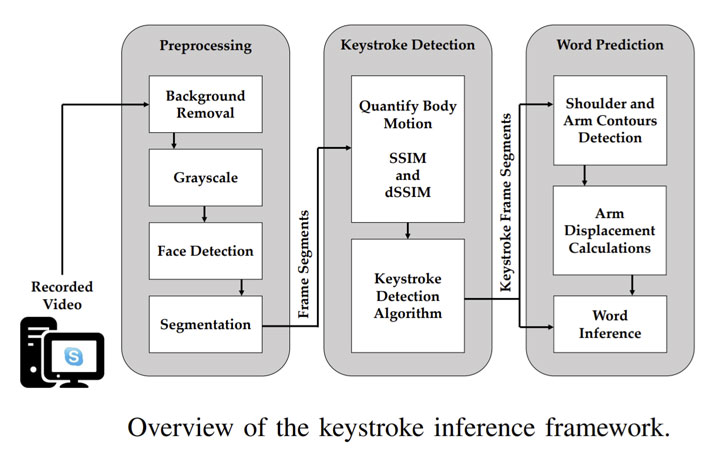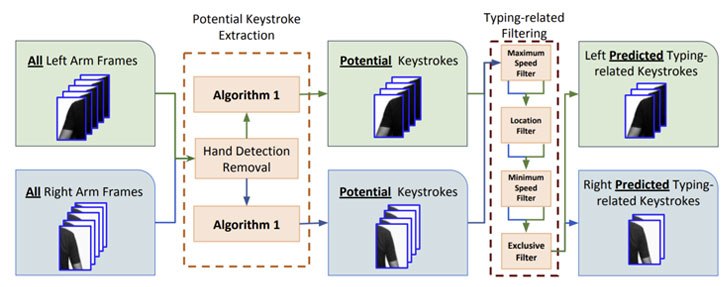A new attack framework aims to infer keystrokes typed by a
target user at the opposite end of a video conference call by
simply leveraging the video feed to correlate observable body
movements to the text being typed.
The research was undertaken by Mohd Sabra, and Murtuza Jadliwala
from the University of Texas at San Antonio and Anindya Maiti from
the University of Oklahoma, who say the attack can be extended
beyond live video feeds to those streamed on YouTube and Twitch as
long as a webcam’s field-of-view captures the target user’s visible
upper body movements.
“With the recent ubiquity of video capturing hardware embedded
in many consumer electronics, such as smartphones, tablets, and
laptops, the threat of information leakage through visual
channel[s] has amplified,” the researchers said[1]. “The adversary’s goal
is to utilize the observable upper body movements across all the
recorded frames to infer the private text typed by the target.”
To achieve this, the recorded video is fed into a video-based
keystroke inference framework that goes through three stages —
- Pre-processing, where the background is removed, the video is
converted to grayscale, followed by segmenting the left and right
arm regions with respect to the individual’s face detected via a
model dubbed FaceBoxes[2] - Keystroke detection, which retrieves the segmented arm frames
to compute the structural similarity index measure (SSIM[3]) with the goal of
quantifying body movements between consecutive frames in each of
the left and right side video segments and identify potential
frames where keystrokes happened - Word prediction, where the keystroke frame segments are used to
detect motion features before and after each detected keystroke,
using them to infer specific words by utilizing a dictionary-based
prediction algorithm
In other words, from the pool of detected keystrokes, words are
inferred by making use of the number of keystrokes detected for a
word as well as the magnitude and direction of arm displacement
that occurs between consecutive keystrokes of the word.
This displacement is measured using a computer vision technique
called Sparse optical flow that’s used to track shoulder and arm
movements across chronological keystroke frames.
Additionally, a template for “inter-keystroke directions on the
standard QWERTY keyboard” is also charted to denote the “ideal
directions a typer’s hand should follow” using a mix of left and
right hands.
The word prediction algorithm, then, searches for most likely
words that match the order and number of left and right-handed
keystrokes and the direction of arm displacements with the template
inter-keystroke directions.
The researchers said they tested the framework with 20
participants (9 females and 11 males) in a controlled scenario,
employing a mix of hunt-and-peck and touch typing methods, aside
from testing the inference algorithm against different backgrounds,
webcam models, clothing (particularly the sleeve design),
keyboards, and even various video-calling software such as Zoom,
Hangouts, and Skype.
The findings showed that hunt-and-peck typers and those wearing
sleeveless clothes were more susceptible to word inference attacks,
as were users of Logitech webcams, resulting in improved word
recovery than those who used external webcams from Anivia.
The tests were repeated again with 10 more participants (3
females and 7 males), this time in an experimental home setup,
successfully inferring 91.1% of the username, 95.6% of the email
addresses, and 66.7% of the websites typed by participants, but
only 18.9% of the passwords and 21.1% of the English words typed by
them.
“One of the reasons our accuracy is worse than the In-Lab
setting is because the reference dictionary’s rank sorting is based
on word-usage frequency in English language sentences, not based on
random words produced by people,” Sabra, Maiti, and Jadliwala
note.
Stating that blurring, pixelation, and frame skipping can be an
effective mitigation ploy, the researchers said the video data can
be combined with audio data from the call to further improve
keystroke detection.
“Due to recent world events, video calls have become the new
norm for both personal and professional remote communication,” the
researchers highlight. “However, if a participant in a video call
is not careful, he/she can reveal his/her private information to
others in the call. Our relatively high keystroke inference
accuracies under commonly occurring and realistic settings
highlight the need for awareness and countermeasures against such
attacks.”
The findings are expected to be presented later today at the
Network and Distributed System Security Symposium (NDSS).




